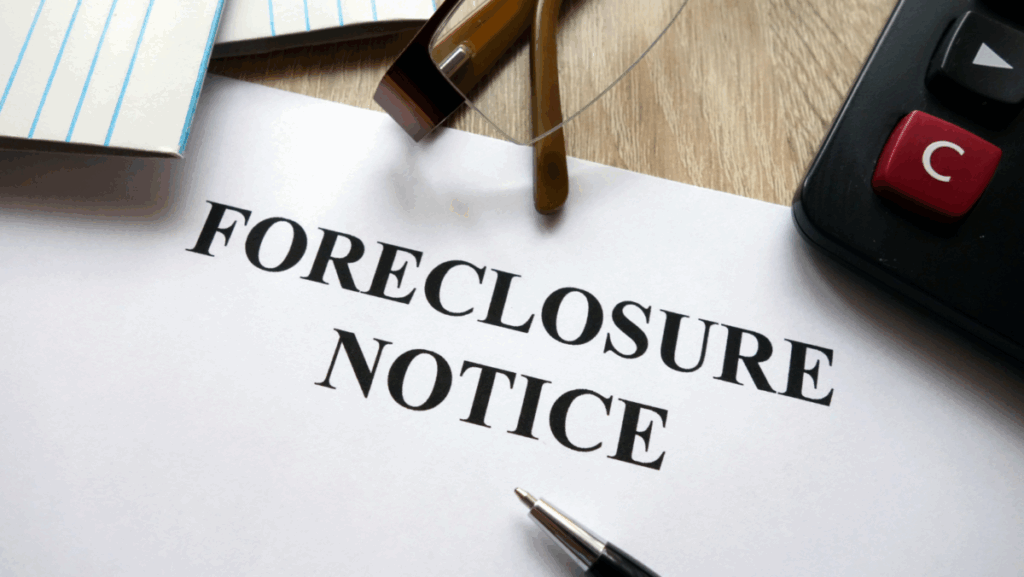Foreclosure Notice of Default in MD – What Is It?

Introduction
If you’ve received a Foreclosure Notice of Default in Maryland, you’re likely feeling overwhelmed, anxious, and uncertain about what to do next. The reality of potentially losing your home can be incredibly stressful, and you might be grappling with confusion about your legal rights, options for resolving the situation, and the impact it could have on your financial future. As a homeowner facing foreclosure, your primary concerns are probably:
- Understanding what a Foreclosure Notice of Default is and what it means for you.
- How to stop foreclosure or avoid losing your home, and the different alternatives available, such as a short sale.
- What to do next in terms of legal action or seeking professional help.
- How the process works, and what your timeline looks like.
- The potential financial consequences—including the impact on your credit score and future homeownership prospects.
As someone in this difficult situation, it’s essential to receive clear, actionable information that empowers you to make informed decisions. This blog post will walk you through everything you need to know about a Foreclosure Notice of Default in Maryland, explaining the process, options for dealing with it, and why selling your house for cash might be the quickest and most reliable solution.
What is a Foreclosure Notice of Default in Maryland?
When you receive a Foreclosure Notice of Default in Maryland, it’s one of the first official steps in the foreclosure process. This notice means that you have missed multiple mortgage payments, and your lender is taking legal action to repossess your home. In Maryland, foreclosures are judicial, meaning the lender must file a lawsuit in court before they can proceed with foreclosure.
Key Points to Understand:
A Notice of Default does not immediately mean you will lose your home, but it does signal that you are in serious danger of foreclosure if you don’t take action. It is a critical warning that the lender is beginning legal proceedings to repossess your property.
When this notice is filed, you may have up to 45 days to resolve the situation before the lender proceeds to the next step. This is a crucial window where you may be able to negotiate with the lender or pursue foreclosure alternatives.
For more details about foreclosure laws in Maryland, check out this overview of Maryland foreclosure process from Nolo’s guide to Maryland foreclosure laws and procedures.
Foreclosure Process in Maryland: What Happens After the Notice of Default?
After receiving a Foreclosure Notice of Default, the next steps depend on your actions. Here’s a breakdown of the process:
- Notice of Default (NOD): This notice gives you 45 days to bring your mortgage current or otherwise resolve the issue.
- Filing of Foreclosure Complaint: If the default isn’t cured within the 45-day period, the lender can file a foreclosure complaint in Maryland’s court system. A hearing will be scheduled to review the case.
- Judgment of Foreclosure: If the judge rules in favor of the lender, a judgment of foreclosure will be issued. This means the bank has the legal right to sell your home at auction.
- Foreclosure Sale: Finally, the home is sold at a public auction, and the proceeds are used to pay off the loan. Any remaining balance may still be your responsibility.
This judicial process means you have a chance to fight the foreclosure in court, but it also gives you limited time to act before the situation escalates. If you feel overwhelmed by this process and are unsure about the next steps, this is where professional help, such as from a real estate investor, can be incredibly beneficial. You may also want to consider exploring options like a short sale, which is an alternative to foreclosure. For more on that, visit Short Sale vs. Foreclosure – What’s the Difference?.
Options for Dealing with a Foreclosure Notice of Default in Maryland
Now that we’ve discussed the foreclosure process, you might be wondering: what are my options? The good news is that there are several ways to deal with a Notice of Default and avoid losing your home to foreclosure.
1. Loan Modification
If you’re behind on your mortgage payments but can afford the future payments, you can work with your lender to modify the terms of your loan. This might include reducing your interest rate, extending the length of the loan, or even deferring some of the payments.
Pros:
- Keeps you in your home and can lower future payments.
- It may help improve your financial situation long-term.
Cons:
- The process can be slow and requires negotiation.
- Not all loan modifications are accepted by the lender.
2. Repayment Plan
A repayment plan may allow you to catch up on your missed payments over a set period. If you’ve fallen behind by a few months, this may be a feasible option for you.
Pros:
- It can provide a clear path to get back on track.
Cons:
- If you’re already in financial trouble, adding extra payments may make things worse.
3. Forbearance
Forbearance offers a temporary reprieve where the lender allows you to pause or reduce payments for a period of time.
Pros:
- A short-term solution to get you through a financial hardship.
Cons:
- Payments may still be required after the forbearance period ends.
4. Short Sale
A short sale involves selling your home for less than the outstanding mortgage balance, with the lender’s approval. This can be a good option if your home’s market value is lower than the mortgage balance.
Pros:
- Avoids foreclosure and its negative impact on your credit.
- The lender may forgive the remaining debt.
Cons:
- It’s a lengthy process that requires lender approval.
- You may still face some financial consequences.
Learn more about short sales with this comprehensive article from Investopedia on Short Sales.
5. Selling for Cash
Selling your home for cash can be the most direct and effective way to avoid foreclosure. By selling your house quickly to a cash buyer (like a real estate investor), you can avoid the lengthy foreclosure process and prevent damage to your credit.
How Selling Your House for Cash Can Help Avoid Foreclosure in Maryland
While there are multiple foreclosure alternatives, selling your house for cash is one of the quickest and most effective ways to avoid foreclosure.
Why Selling for Cash is Beneficial:
- Fast Closing: Cash offers can close in as little as 7-14 days, whereas traditional sales take much longer.
- No Repairs Needed: Many homeowners in foreclosure are unable to make repairs or updates to their property. With cash buyers, you sell the house “as is,” saving time and money.
- Avoiding Foreclosure: A quick sale can help you avoid the public auction and the damage to your credit that comes with foreclosure.
- No Fees or Commissions: When selling for cash, you don’t need to worry about real estate agent commissions or closing fees, which are common in traditional sales.
Example: If you owe $250,000 on your mortgage, but your house is only worth $200,000, a cash buyer may be willing to offer you cash for the home and help you avoid foreclosure while possibly negotiating a deal to forgive the rest of the debt.
By selling your home for cash, you avoid the stress of trying to navigate a lengthy foreclosure process, and you may be able to keep your credit intact. If you’re considering this option, check out our comprehensive guide on How to Stop the Bank from Foreclosing on Your Maryland House and discover how selling for cash can work for you.
The Consequences of Foreclosure in Maryland
While many people hope to avoid foreclosure, it’s essential to understand the long-term consequences of foreclosure and why it’s worth considering selling for cash.
- Credit Damage: A foreclosure can remain on your credit report for up to seven years, severely impacting your ability to buy a new home, apply for loans, or even secure employment in some cases.
- Deficiency Judgment: Even after the foreclosure sale, you may still be responsible for the remaining balance on your mortgage if the sale doesn’t cover it. This is called a deficiency judgment, and it can lead to wage garnishment or bank account levies.
- Emotional Toll: Beyond the financial consequences, foreclosure can be emotionally draining. The uncertainty of the process can create stress for homeowners and their families.
How Selling for Cash Can Mitigate These Issues:
By selling your home for cash, you can avoid the deficiency judgment, preserve your credit, and relieve the emotional strain of foreclosure. The quicker you act, the better your chances of moving forward with your life, whether you’re looking to rent, buy, or simply stabilize your finances.
Conclusion: Is Selling for Cash Your Best Option?
In conclusion, receiving a Foreclosure Notice of Default in Maryland can feel overwhelming and stressful, but it’s important to remember that you do have options. While solutions like loan modifications, short sales, and forbearance may provide temporary relief, selling your home for cash is often the quickest and most reliable way to avoid foreclosure and its long-term financial consequences.
By selling to Simple Homebuyers, you can bypass the lengthy foreclosure process, avoid costly repairs, and close the deal in as little as 7-14 days. This allows you to move forward with your life without the lasting impact of a foreclosure on your credit and financial future.
If you’re ready to take action and explore how a cash sale can benefit you, Simple Homebuyers is here to help. We understand the urgency of your situation, and we’re committed to providing you with a fair, no-obligation cash offer. Contact us today, and let us help you find the best solution to avoid foreclosure and regain control of your future.

